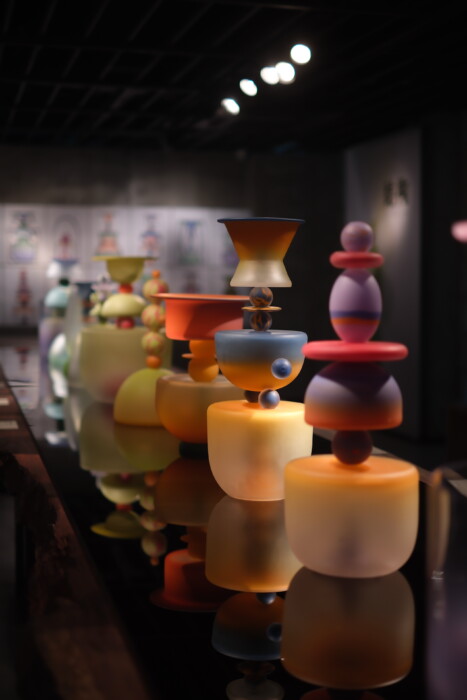Encounters with blown glass: light and glass
Jinya Zhao
As you step into the exhibition of my artworks at Hauser & Wirth, you are immediately greeted by the interplay of glass and light against the window. The environment is alive with colour and light, ever-changing as people pass by, casting shifting shadows and flooded highlights. These dynamic interactions lead to a phenomenon such as metamerism (Luo 2006), where colours appear to change based on different viewing conditions. Metamerism manifests in four types: illuminant, observer, field size, and geometric. Each adding a layer of complexity to a viewer’s experience.1
The shifting visual experience is deeply personal, influenced by each observer’s unique sensory perceptions, memories, and associations. These may include emotional states, as well as religious, cultural, and personal backgrounds, of which all shape how the artworks are perceived. Additionally, viewers might experience synesthetic responses (van Campen 2010) or have alternative sensory (Sacks 1998, 2009) perceptions of colour. An intriguing example of this is chromesthesia, a type of synaesthesia where specific colours are associated with sounds. This alternative sensory perception of colour enriches the viewing experience, making it a uniquely individual journey through the exhibition.
Our senses lead us to ponder: what exactly are we seeing? Colour, in this context, transcends being a mere quality; it becomes an elusive, almost non-existent entity. Synaesthesia, the blending of senses, further complicates this sensory experience. This interaction of perception and sensation raises critical research questions. How is a viewer’s perception affected by the interplay of colour and light in forms of blown glass? What theoretical framework can be used to discuss these phenomena within my glass practice? How are colours and surfaces within my work perceived? How do my works of glass evoke memories?
To delve into these questions, I propose to develop the concept of ‘synaesthetic touch’. This idea offers to enhance the visual experience of blown glass sculpture, guiding a viewer from mere sight to something akin to a tactile sensation, more as if they are touching the artwork with vision. This approach allows information from one sense (vision) to influence and even transform another, in what I am currently thinking is ‘synaesthetic touch’. The aim of developing and expanding a creative practice which explores this term is to engage viewers more fully with their senses. This concept doesn’t just expand the boundaries of how we might perceive glass artworks; it blurs the lines between the senses, encouraging a deeper, more immersive interaction with the artwork. By doing so, it invites viewers to explore their own sensory experiences and associations, and to develop a unique and personal connection with each piece. In this way, ‘synaesthetic touch’ becomes a tool not just for perception, but for emotional and experiential exploration within the realm of glass art.
Footnote
1. Illuminant metamerism is the most important type of metamerism and occurs when two samples appear to match well under one illuminant but exhibit a large mismatch under a second illuminant. Observer metamerism occurs when a pair of samples matches for one observer but fails to match when seen by a second. Field size metamerism arises from a satisfactory match being lost when the field size changes. Geometric metamerism occurs when a mismatch develops due to changes in the illumination and viewing geometry.
References
Luo, M.R. (2006). Colour Quality Evaluation. Total Colour Management in Textiles a Volume in Woodhead Publishing Series in Textiles, pp.57–75. doi: https://doi.org/10.1533/9781845691080.57.
Sacks, O.W. (1998). The Island of the Colorblind; and, Cycad Island. New York, NY: Vintage Books, p. 23.
Sacks, O.W. (2009). Seeing Voices: a Journey into the World of the Deaf. London: Picador, p.5.
van Campen, C. (2010). Leonardo Book Series: Hidden Sense: Synesthesia in Art and Science. Cambridge, MA: The MIT Press, p. 12.
Image caption
Exhibition view of Nebulosity Walk in Thy Memory, Jinya Zhao Glass Art Exhibition, 2023. Liuli China Museum. Photo Credit: Homer He.

Encounters with blown glass: light and glass
Encounters with blown glass: light and glass

Conversation: where critical friends of itinerant space are invited to comment on journal submissions as part of an ongoing research dialogue.